Paper Menu >>
Journal Menu >>
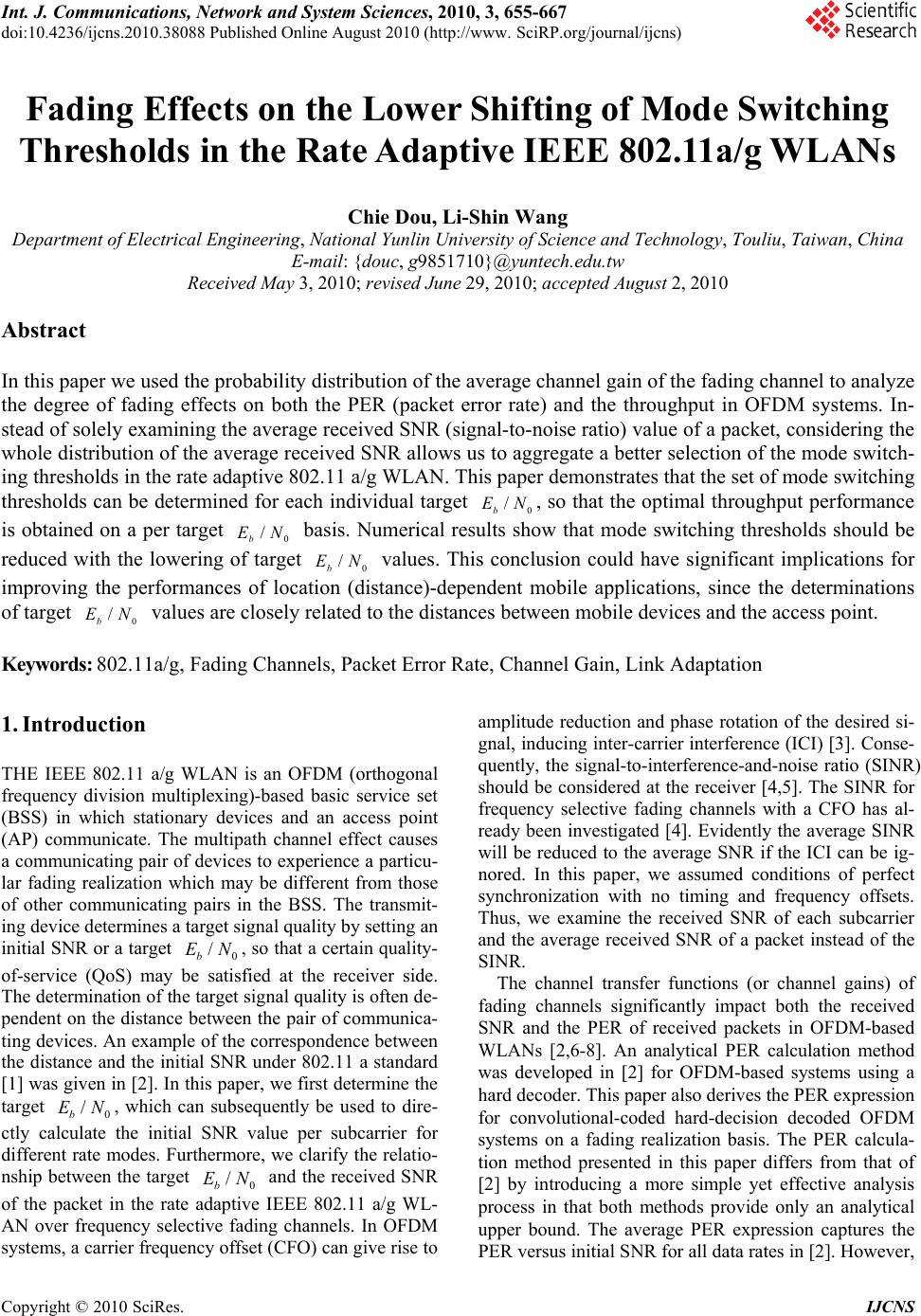 Int. J. Communications, Network and System Sciences, 2010, 3, 655-667 doi:10.4236/ijcns.2010.38088 Published Online August 2010 (http://www. SciRP.org/journal/ijcns) Copyright © 2010 SciRes. IJCNS Fading Effects on the Lower Shifting of Mode Switching Thresholds in the Rate Adaptive IEEE 802.11a/g WLANs Chie Dou, Li-Shin Wang Department of Electrical Engineering, National Yunlin University of Science and Technology, Touliu, Taiwan, China E-mail: {douc, g9851710}@yuntech.edu.tw Received May 3, 2010; revised June 29, 2010; accepted August 2, 2010 Abstract In this paper we used the probability distribution of the average channel gain of the fading channel to analyze the degree of fading effects on both the PER (packet error rate) and the throughput in OFDM systems. In- stead of solely examining the average received SNR (signal-to-noise ratio) value of a packet, considering the whole distribution of the average received SNR allows us to aggregate a better selection of the mode switch- ing thresholds in the rate adaptive 802.11 a/g WLAN. This paper demonstrates that the set of mode switching thresholds can be determined for each individual target , so that the optimal throughput performance is obtained on a per target basis. Numerical results show that mode switching thresholds should be reduced with the lowering of target values. This conclusion could have significant implications for improving the performances of location (distance)-dependent mobile applications, since the determinations of target values are closely related to the distances between mobile devices and the access point. 0 /NEb 0 /NEb 0 /NEb 0 /NEb Keywords: 802.11a/g, Fading Channels, Packet Error Rate, Channel Gain, Link Adaptation 1. Introduction THE IEEE 802.11 a/g WLAN is an OFDM (orthogonal frequency division multiplexing)-based basic service set (BSS) in which stationary devices and an access point (AP) communicate. The multipath channel effect causes a communicating pair of devices to experience a particu- lar fading realization which may be different from those of other communicating pairs in the BSS. The transmit- ing device determines a target signal quality by setting an initial SNR or a target , so that a certain quality- of-service (QoS) may be satisfied at the receiver side. The determination of the target signal quality is often de- pendent on the distance between the pair of communica- ting devices. An example of the correspondence between the distance and the initial SNR under 802.11 a standard [1] was given in [2]. In this paper, we first determine the target , which can subsequently be used to dire- ctly calculate the initial SNR value per subcarrier for different rate modes. Furthermore, we clarify the relatio- nship between the target and the received SNR of the packet in the rate adaptive IEEE 802.11 a/g WL- AN over frequency selective fading channels. In OFDM systems, a carrier frequency offset (CFO) can give rise to amplitude reduction and phase rotation of the desired si- gnal, inducing inter-carrier interference (ICI) [3]. Conse- quently, the signal-to-interference-and-noise ratio (SINR) should be considered at the receiver [4,5]. The SINR for frequency selective fading channels with a CFO has al- ready been investigated [4]. Evidently the average SINR will be reduced to the average SNR if the ICI can be ig- nored. In this paper, we assumed conditions of perfect synchronization with no timing and frequency offsets. Thus, we examine the received SNR of each subcarrier and the average received SNR of a packet instead of the SINR. 0 /NEb /NEb 0 /NEb 0 The channel transfer functions (or channel gains) of fading channels significantly impact both the received SNR and the PER of received packets in OFDM-based WLANs [2,6-8]. An analytical PER calculation method was developed in [2] for OFDM-based systems using a hard decoder. This paper also derives the PER expression for convolutional-coded hard-decision decoded OFDM systems on a fading realization basis. The PER calcula- tion method presented in this paper differs from that of [2] by introducing a more simple yet effective analysis process in that both methods provide only an analytical upper bound. The average PER expression captures the PER versus initial SNR for all data rates in [2]. However,  656 C. DOU ET AL. it does not provide insight into the influence that the dis- tribution of the channel transfer function (or channel gain) over the subcarriers has on the PER. This paper uses the probability distribution of the average channel gain of the fading channel to analyze the degree of fading effects on both the PER and the throughput in OFDM systems. The average channel gain of a fading realization is ob- tained by averaging the channel gains over all subcarriers. A similar definition of the average channel gain can be found in [9]. Estimation schemes based on an “indicator” concept obtain accurate predictions of the PER via eva- luations of the channel transfer function [6,7]. The esti- mated variance of the transfer function amplitude serves as a simple but effective indicator. However, indicator- aided SNR estimations and direct PER predictions must take into account some complex optimizations of param- eters that may cause errors in channel estimation. A con- ventional link adaptation algorithm takes the measured SNR as the only input from the PHY layer; there exists the possibility that it ignores the stochastic variability of the multipath fading channel and does not exploit the full potential of the link adaptation [6,7]. Instead of solely examining the average received SNR value of a packet, this paper considers the whole distribution of the average received SNR in a way that facilitates a better perform- ance of link adaptation by exploiting the stochastic vari- ability of the multipath fading channel. Previously, two analytical methods have been presented for estimating the bit error rate (BER) of coded multicarrier systems operating over frequency-selective quasi-static channels with non ideal interleaving [8]. However, explicit know- ledge of Rayleigh-distributed frequency-domain subcar- rier channel gains and their correlation matrices are pre- requisites for finding the BER. In this paper, the average PER of individual average received SNR value is obtained for different rate modes both by an analytical approach and by the simulation on a per target 0 basis. The influences of the proba- bility distribution of average channel gain on the average PER are investigated and compared between ETSI (Eur- opean telecommunications standards institute) BRAN A and C channel models [10]. Performance result of the average PER shows that under a given rate mode, better PER performance is obtained with the same average re- ceived SNR by lowering the target 0 value. This observation has significant impact on the determination of mode switching thresholds in 802.11a/g link adapta- tion. /NEb /NEb For conventional link adaptation techniques, a set of mode switching thresholds for the received SNR is cho- sen for different rate modes based on the achieved th- roughput taking the PER for each rate mode into account [11,12] or based on the delay performance of a certain target PER for all rate modes [13]. Unlike conventional link adaptation techniques, in this paper an optimal set of mode switching thresholds is determined for each target 0. Numerical results show that mode switching thr- esholds should be shifted downwards with the lowering of target 0 values. This conclusion is useful in im- proving the performances of location (distance)-dep- endent mobile applications, such as distributed camera network (DCN). In a DCN, digital cameras using 802.11 protocol for video transmissions may have different tar- get 0 values according to the distances between their locations and the access point. The performances of video transmissions in a DCN can be improved if each particular digital camera can use the optimal set of mode switching thresholds determined by the corresponding target . /NEb /Eb /NEb N /N0b The rest of this paper is organized as follows. Section 2 presents the channel fading effects in OFDM-based sy- stems. The impact of channel gains over subcarriers on the average received SNR of a received packet is inves- tigated. For the rate adaptive 802.11a/g WLAN, an ana- lytical approach is proposed to obtain the average PER of individual average received SNR value for different rate modes on a per target basis. Instead of just looking at the average received SNR value of a packet, we consider the whole distribution of the average re- ceived SNR, which leads to a better average PER and also throughput performances. Section 3 presents the simulation model and the channel estimation technique. The average PER derived from the analytical upper bound is compared to the simulation. Numerical results and their applications to the throughput-based link adap- tation in 802.11a/g WLAN are presented in Section 4. We demonstrate that the set of mode switching thresh- olds can be determined for each individual target for optimal throughput performance. Numerical results show that mode switching thresholds should be reduced with the lowering of target values. Finally, Section 5 states the conclusions. E 0 /NEb 0 /NEb 0 /NEb 2. Fading Effects in OFDM-Based Systems Figure 1 shows a block diagram of OFDM-based sys- tems using N-point IFFT/FFT in an equivalent low-pass Transmitted Data Received Data S/P Con- verter P/S Con- verter Signal Mapper Signal De- ma pp er OFDM Modu- lation (IFFT) OFDM Demodu- lation (FFT) P/S Con- verter S/P Con- verter Add Cyclic Prefix Remove Cyclic Prefix D/A Con- verter A/D Con- verter dn [0] x n [0] dn [N-1] x n [N-1] Yn [N-1] Yn [0] Multip a t h Channel AWGN s(t) h(t) n(t) r(t) Figure 1. Block diagram of OFDM-based systems in an eq- uivalent low-pass system. Copyright © 2010 SciRes. IJCNS 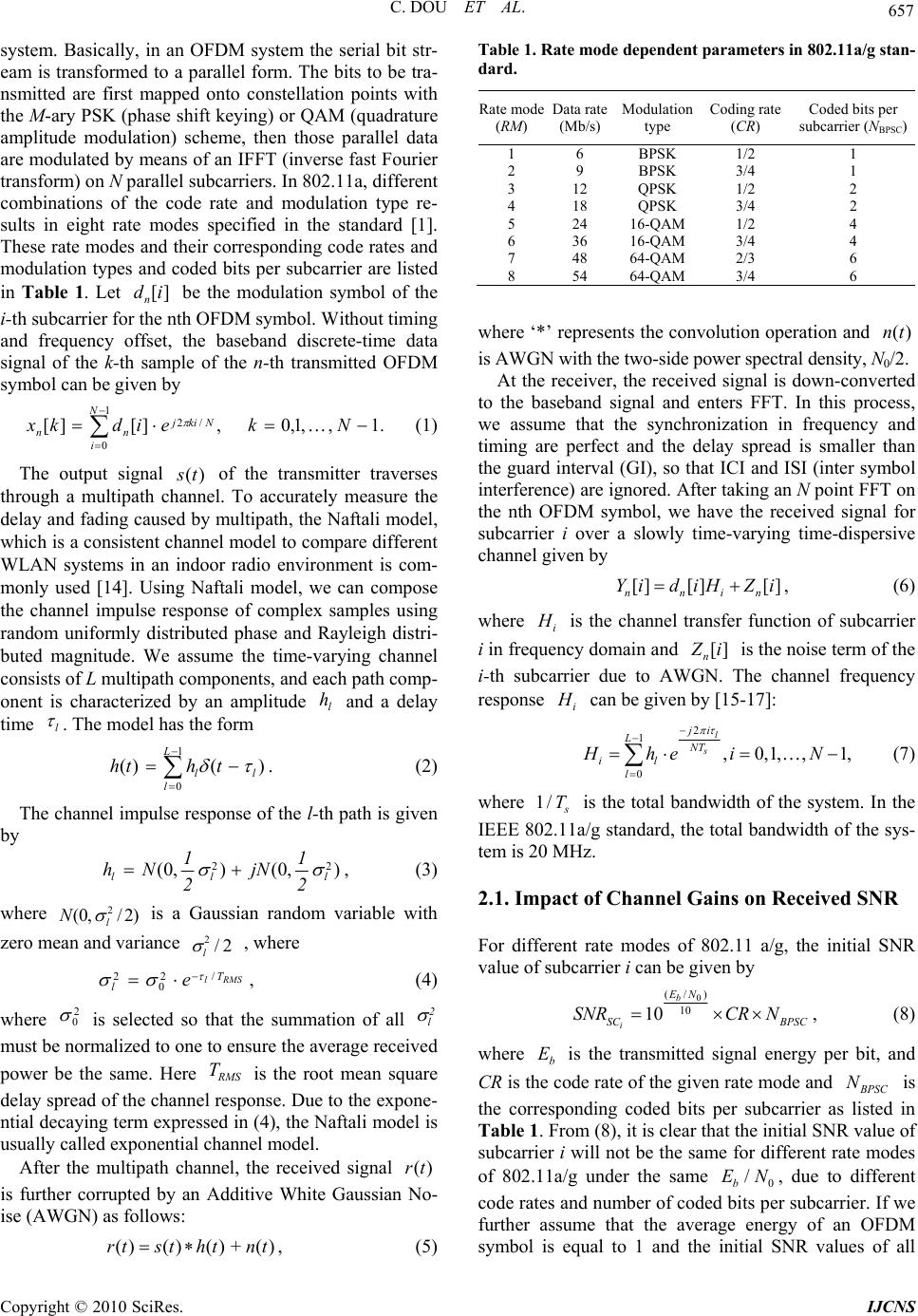 C. DOU ET AL. 657 system. Basically, in an OFDM system the serial bit str- eam is transformed to a parallel form. The bits to be tra- nsmitted are first mapped onto constellation points with the M-ary PSK (phase shift keying) or QAM (quadrature amplitude modulation) scheme, then those parallel data are modulated by means of an IFFT (inverse fast Fourier transform) on N parallel subcarriers. In 802.11a, different combinations of the code rate and modulation type re- sults in eight rate modes specified in the standard [1]. These rate modes and their corresponding code rates and modulation types and coded bits per subcarrier are listed in Table 1. Let be the modulation symbol of the i-th subcarrier for the nth OFDM symbol. Without timing and frequency offset, the baseband discrete-time data signal of the k- th sample of the n-th transmitted OFDM symbol can be given by ][idn .1,,1,0,][][ 1 0 /2 Nk eidkx N i Nkij nn (1) The output signal of the transmitter traverses through a multipath channel. To accurately measure the delay and fading caused by multipath, the Naftali model, which is a consistent channel model to compare different WLAN systems in an indoor radio environment is com- monly used [14]. Using Naftali model, we can compose the channel impulse response of complex samples using random uniformly distributed phase and Rayleigh distri- buted magnitude. We assume the time-varying channel consists of L multipath components, and each path comp- onent is characterized by an amplitude and a delay time )(ts l h l . The model has the form 0 )()( l ll thth 1L . (2) The channel impulse response of the l-th path is given by ),0(),0( 22 lll 2 1 jN 2 1 Nh , (3) where )2/ ,0(2 l N is a Gaussian random variable with zero mean and variance 2/2 l , where RMSl T le/ 2 0 2 , (4) where is selected so that the summation of all 2 0 2 l must be normalized to one to ensure the average received power be the same. Here is the root mean square delay spread of the channel response. Due to the expone- ntial decaying term expressed in (4), the Naftali model is usually called exponential channel model. RMS T After the multipath channel, the received signal is further corrupted by an Additive White Gaussian No- ise (AWGN) as follows: ()rt ()()() + ()rt st htnt , (5) Table 1. Rate mode dependent parameters in 802.11a/g stan- dard. Rate mode (RM) Data rate (Mb/s) Modulation type Coding rate (CR) Coded bits per subcarrier (NBPSC) 1 6 BPSK 1/2 1 2 9 BPSK 3/4 1 3 12 QPSK 1/2 2 4 18 QPSK 3/4 2 5 24 16-QAM1/2 4 6 36 16-QAM3/4 4 7 48 64-QAM2/3 6 8 54 64-QAM3/4 6 where ‘*’ represents the convolution operation and is AWGN with the two-side power spectral density, N0/2. ()nt At the receiver, the received signal is down-converted to the baseband signal and enters FFT. In this process, we assume that the synchronization in frequency and timing are perfect and the delay spread is smaller than the guard interval (GI), so that ICI and ISI (inter symbol interference) are ignored. After taking an N point FFT on the nth OFDM symbol, we have the received signal for subcarrier i over a slowly time-varying time-dispersive channel given by [] [][] nnin YidiH Zi , (6) where i H is the channel transfer function of subcarrier i in frequency domain and [] n Z i is the noise term of the i-th subcarrier due to AWGN. The channel frequency response i H can be given by [15-17]: 2 1 0 ,0,1,, 1 l s ji LNT il l Hhe iN , (7) where 1/ s T is the total bandwidth of the system. In the IEEE 802.11a/g standard, the total bandwidth of the sys- tem is 20 MHz. 2.1. Impact of Channel Gains on Received SNR For different rate modes of 802.11 a/g, the initial SNR value of subcarrier i can be given by 0 (/ ) 10 10 b i EN SC BPSC SNRCR N, (8) where is the transmitted signal energy per bit, and CR is the code rate of the given rate mode and b E B PSC N is the corresponding coded bits per subcarrier as listed in Table 1. From (8), it is clear that the initial SNR value of subcarrier i will not be the same for different rate modes of 802.11a/g under the same , due to different code rates and number of coded bits per subcarrier. If we further assume that the average energy of an OFDM symbol is equal to 1 and the initial SNR values of all 0 / b EN Copyright © 2010 SciRes. IJCNS 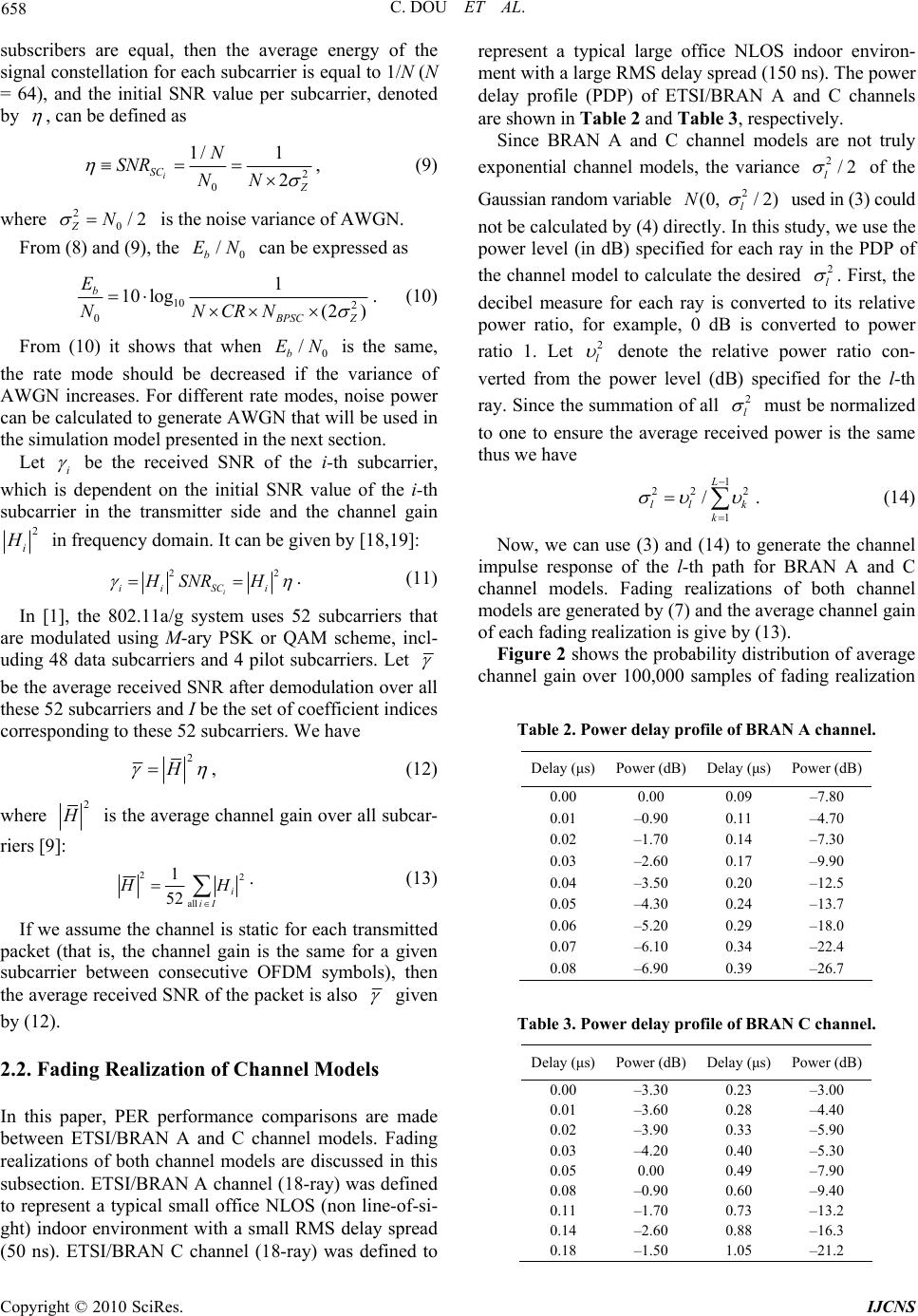 658 C. DOU ET AL. subscribers are equal, then the average energy of the signal constellation for each subcarrier is equal to 1/N (N = 64), and the initial SNR value per subcarrier, denoted by , can be defined as 2 0 1/ 1 2 i SC Z N SNR NN , (9) where is the noise variance of AWGN. 2 0/2 ZN From (8) and (9), the can be expressed as 0 / b EN 10 2 0 1 10 log(2) b B PSC Z E NNCRN . (10) From (10) it shows that when is the same, the rate mode should be decreased if the variance of AWGN increases. For different rate modes, noise power can be calculated to generate AWGN that will be used in the simulation model presented in the next section. 0 / b EN Let i be the received SNR of the i-th subcarrier, which is dependent on the initial SNR value of the i-th subcarrier in the transmitter side and the channel gain 2 i H in frequency domain. It can be given by [18,19]: 2 i iiSC i HSNRH 2 . (11) In [1], the 802.11a/g system uses 52 subcarriers that are modulated using M-ary PSK or QAM scheme, incl- uding 48 data subcarriers and 4 pilot subcarriers. Let be the average received SNR after demodulation over all these 52 subcarriers and I be the set of coefficient indices corresponding to these 52 subcarriers. We have 2 H , (12) where 2 H is the average channel gain over all subcar- riers [9]: Ii i HH all 2 2 52 1. (13) If we assume the channel is static for each transmitted packet (that is, the channel gain is the same for a given subcarrier between consecutive OFDM symbols), then the average received SNR of the packet is also given by (12). 2.2. Fading Realization of Channel Models In this paper, PER performance comparisons are made between ETSI/BRAN A and C channel models. Fading realizations of both channel models are discussed in this subsection. ETSI/BRAN A channel (18-ray) was defined to represent a typical small office NLOS (non line-of-si- ght) indoor environment with a small RMS delay spread (50 ns). ETSI/BRAN C channel (18-ray) was defined to represent a typical large office NLOS indoor environ- ment with a large RMS delay spread (150 ns). The power delay profile (PDP) of ETSI/BRAN A and C channels are shown in Table 2 and Table 3, respectively. Since BRAN A and C channel models are not truly exponential channel models, the variance of the Gaussian random variable used in (3) could not be calculated by (4) directly. In this study, we use the power level (in dB) specified for each ray in the PDP of the channel model to calculate the desired 2/2 l 2 l 2 (0, /2) l N . First, the decibel measure for each ray is converted to its relative power ratio, for example, 0 dB is converted to power ratio 1. Let 2 l denote the relative power ratio con- verted from the power level (dB) specified for the l-th ray. Since the summation of all 2 l must be normalized to one to ensure the average received power is the same thus we have 1 22 1 / L ll k 2 k . (14) Now, we can use (3) and (14) to generate the channel impulse response of the l-th path for BRAN A and C channel models. Fading realizations of both channel models are generated by (7) and the average channel gain of each fading realization is give by (13). Figure 2 shows the probability distribution of average channel gain over 100,000 samples of fading realization Table 2. Power delay profile of BRAN A channel. Delay (μs)Power (dB)Delay (μs) Power (dB) 0.00 0.00 0.09 –7.80 0.01 –0.90 0.11 –4.70 0.02 –1.70 0.14 –7.30 0.03 –2.60 0.17 –9.90 0.04 –3.50 0.20 –12.5 0.05 –4.30 0.24 –13.7 0.06 –5.20 0.29 –18.0 0.07 –6.10 0.34 –22.4 0.08 –6.90 0.39 –26.7 Table 3. Power delay profile of BRAN C channel. Delay (μs)Power (dB)Delay (μs) Power (dB) 0.00 –3.30 0.23 –3.00 0.01 –3.60 0.28 –4.40 0.02 –3.90 0.33 –5.90 0.03 –4.20 0.40 –5.30 0.05 0.00 0.49 –7.90 0.08 –0.90 0.60 –9.40 0.11 –1.70 0.73 –13.2 0.14 –2.60 0.88 –16.3 0.18 –1.50 1.05 –21.2 Copyright © 2010 SciRes. IJCNS 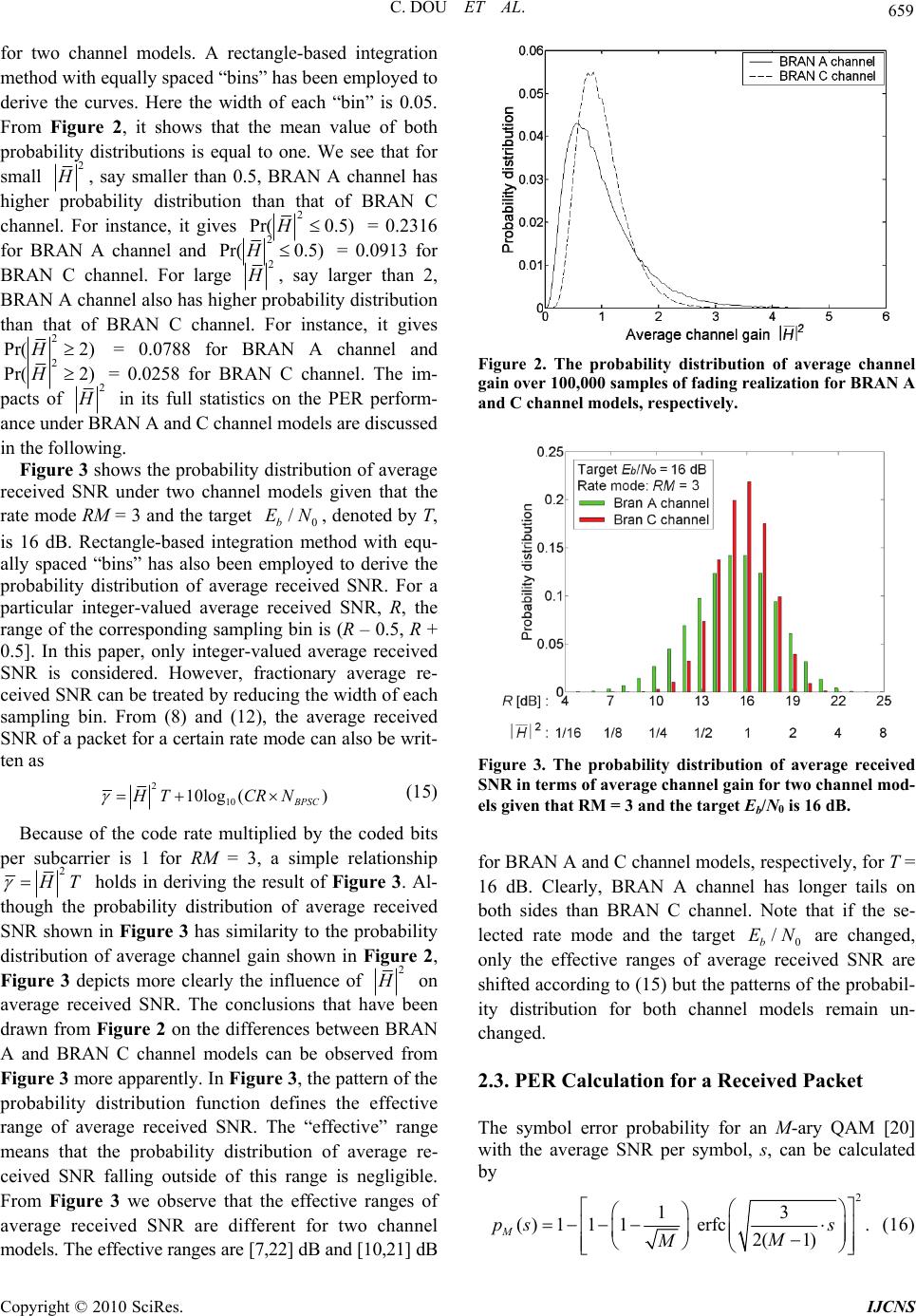 C. DOU ET AL. 659 for two channel models. A rectangle-based integration method with equally spaced “bins” has been employed to derive the curves. Here the width of each “bin” is 0.05. From Figure 2, it shows that the mean value of both probability distributions is equal to one. We see that for small 2 H , say smaller than 0.5, BRAN A channel has higher probability distribution than that of BRAN C channel. For instance, it gives 2 Pr( 0.5)H = 0.2316 for BRAN A channel and 2 Pr( 0.5)H = 0.0913 for BRAN C channel. For large 2 H , say larger than 2, BRAN A channel also has higher probability distribution than that of BRAN C channel. For instance, it gives 2 Pr( 2)H = 0.0788 for BRAN A channel and 2 Pr( 2)H = 0.0258 for BRAN C channel. The im- pacts of 2 H in its full statistics on the PER perform- ance under BRAN A and C channel models are discussed in the following. Figure 3 shows the probability distribution of average received SNR under two channel models given that the rate mode RM = 3 and the target , denoted by T, is 16 dB. Rectangle-based integration method with equ- ally spaced “bins” has also been employed to derive the probability distribution of average received SNR. For a particular integer-valued average received SNR, R, the range of the corresponding sampling bin is (R – 0.5, R + 0.5]. In this paper, only integer-valued average received SNR is considered. However, fractionary average re- ceived SNR can be treated by reducing the width of each sampling bin. From (8) and (12), the average received SNR of a packet for a certain rate mode can also be writ- ten as 0 / b EN 2 10 10log() B PSC HT CRN (15) Because of the code rate multiplied by the coded bits per subcarrier is 1 for RM = 3, a simple relationship 2 H T holds in deriving the result of Figure 3. Al- though the probability distribution of average received SNR shown in Figure 3 has similarity to the probability distribution of average channel gain shown in Figure 2, Figure 3 depicts more clearly the influence of 2 H on average received SNR. The conclusions that have been drawn from Figure 2 on the differences between BRAN A and BRAN C channel models can be observed from Figure 3 more apparently. In Figure 3, the pattern of the probability distribution function defines the effective range of average received SNR. The “effective” range means that the probability distribution of average re- ceived SNR falling outside of this range is negligible. From Figure 3 we observe that the effective ranges of average received SNR are different for two channel models. The effective ranges are [7,22] dB and [10,21] dB Figure 2. The probability distribution of average channel gain over 100,000 samples of fading realization for BRAN A and C channel models, respectively. Figure 3. The probability distribution of average received SNR in terms of average channel gain for two channel mod- els given that RM = 3 and the target Eb/N0 is 16 dB. for BRAN A and C channel models, respectively, for T = 16 dB. Clearly, BRAN A channel has longer tails on both sides than BRAN C channel. Note that if the se- lected rate mode and the target 0 are changed, only the effective ranges of average received SNR are shifted according to (15) but the patterns of the probabil- ity distribution for both channel models remain un- changed. / b EN 2.3. PER Calculation for a Received Packet The symbol error probability for an M-ary QAM [20] with the average SNR per symbol, s, can be calculated by 2 13 ()111 erfc. 2( 1) M ps s M M (16) Copyright © 2010 SciRes. IJCNS 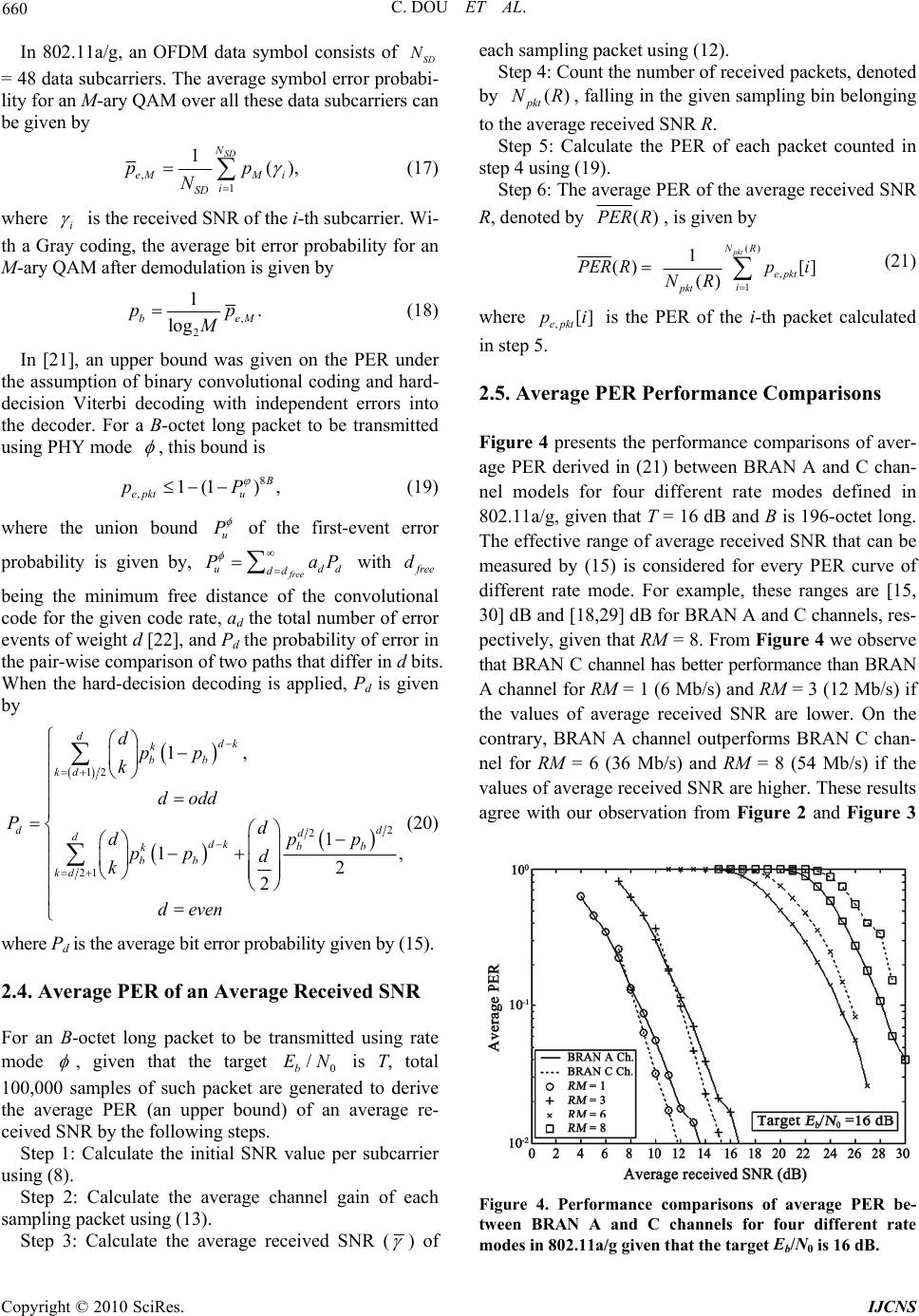 660 C. DOU ET AL. In 802.11a/g, an OFDM data symbol consists of SD N = 48 data subcarriers. The average symbol error probabi- lity for an M-ary QAM over all these data subcarriers can be given by , 1 1(), SD N eMM i i SD pp N (17) where i is the received SNR of the i-th subcarrier. Wi- th a Gray coding, the average bit error probability for an M-ary QAM after demodulation is given by , 2 1. log b p M eM p (18) In [21], an upper bound was given on the PER under the assumption of binary convolutional coding and hard- decision Viterbi decoding with independent errors into the decoder. For a B-octet long packet to be transmitted using PHY mode , this bound is 8 ,1(1), B epktu pP (19) where the union bound u P of the first-event error probability is given by, free ud dd d P aP with f ree d being the minimum free distance of the convolutional code for the given code rate, ad the total number of error events of weight d [22], and Pd the probability of error in the pair-wise comparison of two paths that differ in d bits. When the hard-decision decoding is applied, Pd is given by 12 2 2 21 1, 1 1, 2 2 ddk k bb kd d dd ddk bb k bb kd dpp k dodd Pdpp dpp d k deven (20) where Pd is the average bit error probability given by (15). 2.4. Average PER of an Average Received SNR For an B-octet long packet to be transmitted using rate mode , given that the target is T, total 100,000 samples of such packet are generated to derive the average PER (an upper bound) of an average re- ceived SNR by the following steps. 0 / b EN Step 1: Calculate the initial SNR value per subcarrier using (8). Step 2: Calculate the average channel gain of each sampling packet using (13). Step 3: Calculate the average received SNR ( ) of each sampling packet using (12). Step 4: Count the number of received packets, denoted by , falling in the given sampling bin belonging to the average received SNR R. ( ) pkt NR Step 5: Calculate the PER of each packet counted in step 4 using (19). Step 6: The average PER of the average received SNR R, denoted by ()PERR, is given by () , 1 1 () [] () pkt NR epkt i pkt PER Rpi NR (21) where ,[] epkt p i is the PER of the i- th packet calculated in step 5. 2.5. Average PER Performance Comparisons Figure 4 presents the performance comparisons of aver- age PER derived in (21) between BRAN A and C chan- nel models for four different rate modes defined in 802.11a/g, given that T = 16 dB and B is 196-octet long. The effective range of average received SNR that can be measured by (15) is considered for every PER curve of different rate mode. For example, these ranges are [15, 30] dB and [18,29] dB for BRAN A and C channels, res- pectively, given that RM = 8. From Figure 4 we observe that BRAN C channel has better performance than BRAN A channel for RM = 1 (6 Mb/s) and RM = 3 (12 Mb/s) if the values of average received SNR are lower. On the contrary, BRAN A channel outperforms BRAN C chan- nel for RM = 6 (36 Mb/s) and RM = 8 (54 Mb/s) if the values of average received SNR are higher. These results agree with our observation from Figure 2 and Figure 3 Figure 4. Performance comparisons of average PER be- tween BRAN A and C channels for four different rate modes in 802.11a/g given that the target Eb/N0 is 16 dB. Copyright © 2010 SciRes. IJCNS 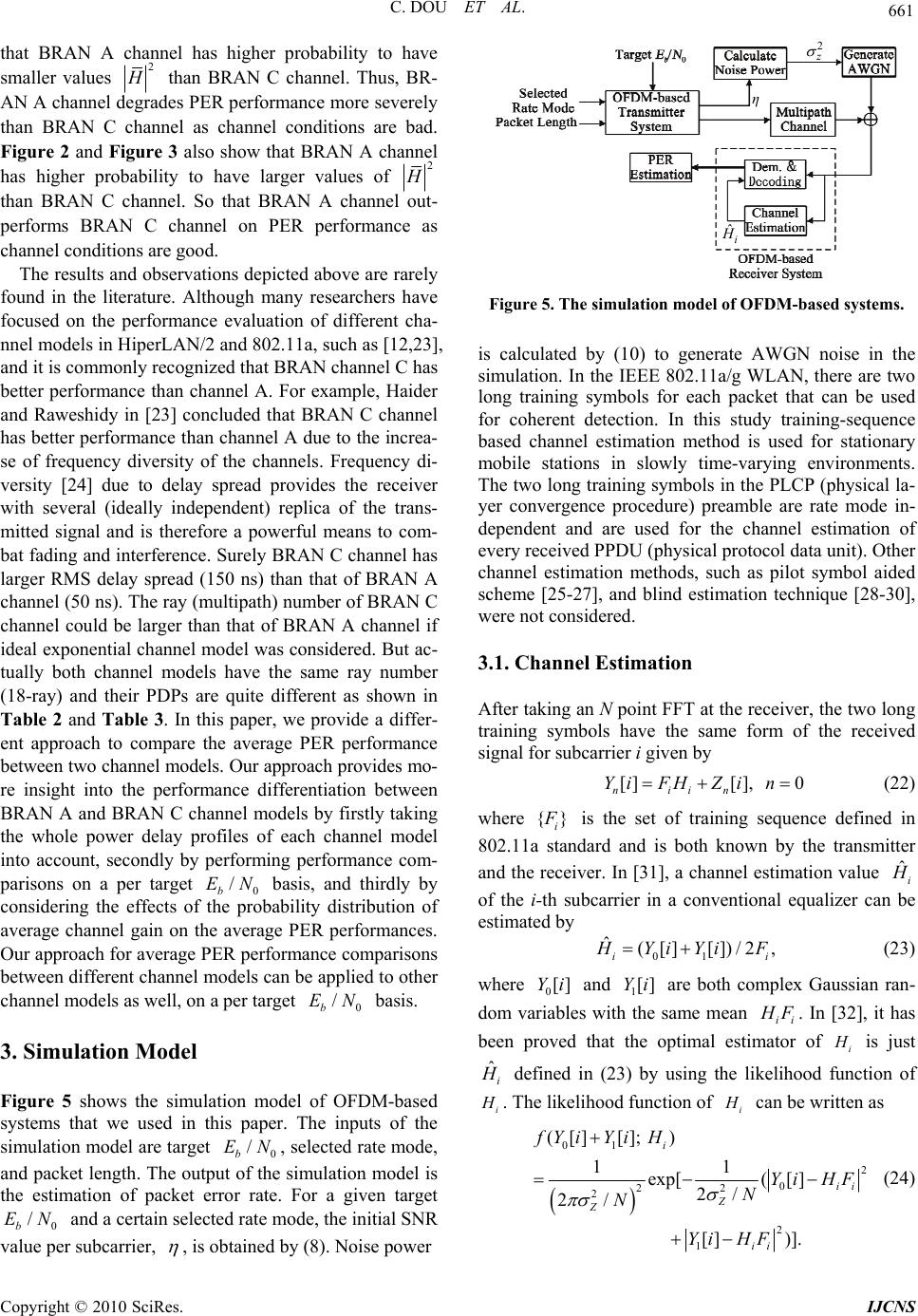 C. DOU ET AL. 661 that BRAN A channel has higher probability to have smaller values 2 H than BRAN C channel. Thus, BR- AN A channel degrades PER performance more severely than BRAN C channel as channel conditions are bad. Figure 2 and Figure 3 also show that BRAN A channel has higher probability to have larger values of 2 H than BRAN C channel. So that BRAN A channel out- performs BRAN C channel on PER performance as channel conditions are good. The results and observations depicted above are rarely found in the literature. Although many researchers have focused on the performance evaluation of different cha- nnel models in HiperLAN/2 and 802.11a, such as [12,23], and it is commonly recognized that BRAN channel C has better performance than channel A. For example, Haider and Raweshidy in [23] concluded that BRAN C channel has better performance than channel A due to the increa- se of frequency diversity of the channels. Frequency di- versity [24] due to delay spread provides the receiver with several (ideally independent) replica of the trans- mitted signal and is therefore a powerful means to com- bat fading and interference. Surely BRAN C channel has larger RMS delay spread (150 ns) than that of BRAN A channel (50 ns). The ray (multipath) number of BRAN C channel could be larger than that of BRAN A channel if ideal exponential channel model was considered. But ac- tually both channel models have the same ray number (18-ray) and their PDPs are quite different as shown in Table 2 and Table 3. In this paper, we provide a differ- ent approach to compare the average PER performance between two channel models. Our approach provides mo- re insight into the performance differentiation between BRAN A and BRAN C channel models by firstly taking the whole power delay profiles of each channel model into account, secondly by performing performance com- parisons on a per target 0 basis, and thirdly by considering the effects of the probability distribution of average channel gain on the average PER performances. Our approach for average PER performance comparisons between different channel models can be applied to other channel models as well, on a per target basis. / b EN 0 / b EN 3. Simulation Model Figure 5 shows the simulation model of OFDM-based systems that we used in this paper. The inputs of the simulation model are target , selected rate mode, and packet length. The output of the simulation model is the estimation of packet error rate. For a given target and a certain selected rate mode, the initial SNR value per subcarrier, 0 / b EN 0 / b EN , is obtained by (8). Noise power 2 z η ˆi H Figure 5. The simulation model of OFDM-based systems. is calculated by (10) to generate AWGN noise in the simulation. In the IEEE 802.11a/g WLAN, there are two long training symbols for each packet that can be used for coherent detection. In this study training-sequence based channel estimation method is used for stationary mobile stations in slowly time-varying environments. The two long training symbols in the PLCP (physical la- yer convergence procedure) preamble are rate mode in- dependent and are used for the channel estimation of every received PPDU (physical protocol data unit). Other channel estimation methods, such as pilot symbol aided scheme [25-27], and blind estimation technique [28-30], were not considered. 3.1. Channel Estimation After taking an N point FFT at the receiver, the two long training symbols have the same form of the received signal for subcarrier i given by [][], 0 niin YiFH Zi n (22) where {} i F is the set of training sequence defined in 802.11a standard and is both known by the transmitter and the receiver. In [31], a channel estimation value ˆi H of the i-th subcarrier in a conventional equalizer can be estimated by 01 ˆ([] [])/2, ii H Yi YiF (23) where and are both complex Gaussian ran- dom variables with the same mean 0[]Yi 1[]Yi ii H F. In [32], it has been proved that the optimal estimator of is just i H ˆi H defined in (23) by using the likelihood function of . The likelihood function of can be written as i Hi H 01 2 0 22 2 2 1 ([][]; ) 11 exp[([] 2/ 2/ [])]. i ii Z Z ii fYiYi H Yi HF N N Yi HF (24) Copyright © 2010 SciRes. IJCNS 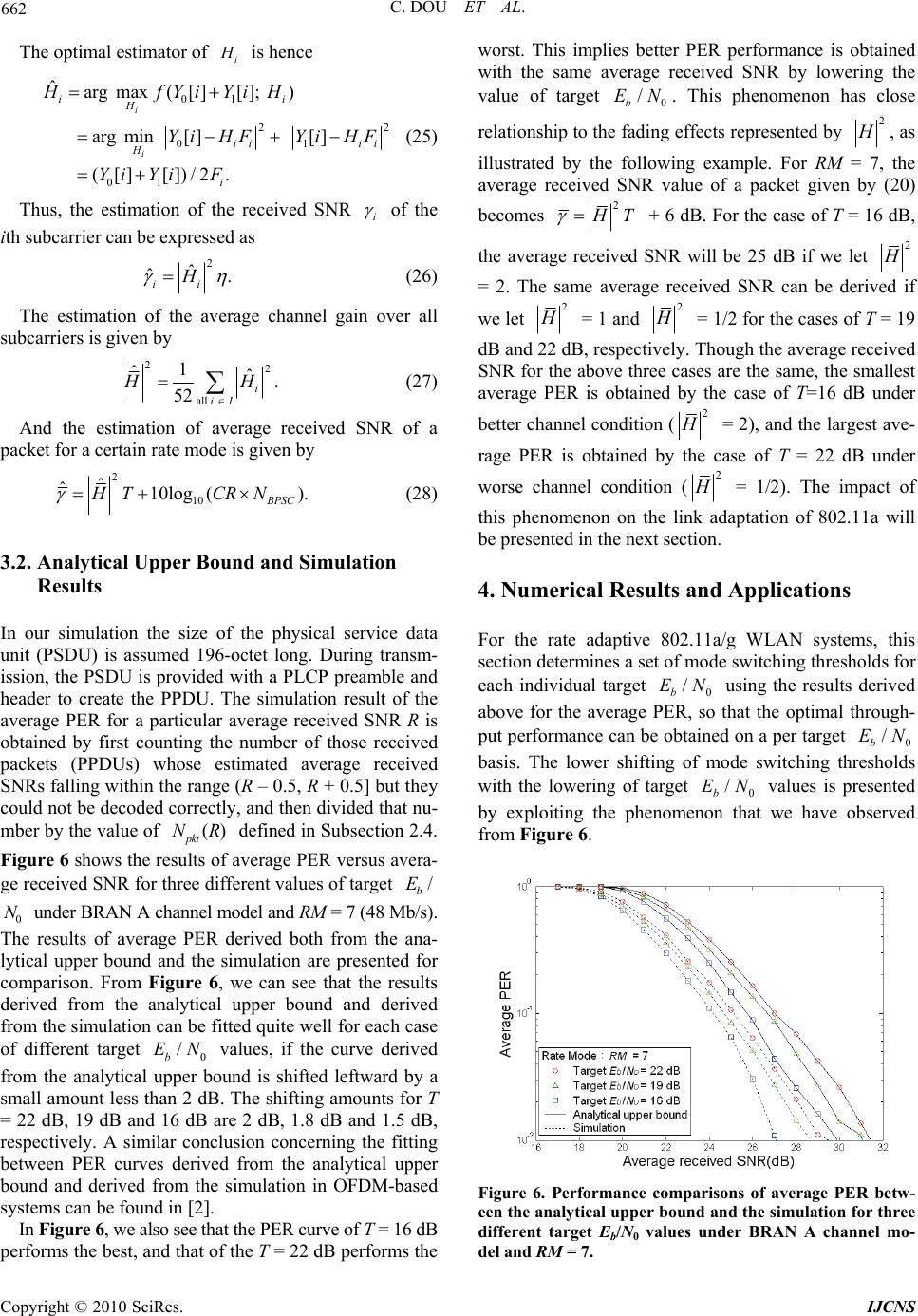 662 C. DOU ET AL. The optimal estimator of is hence i H 01 2 01 01 ˆarg max ([][]; ) arg min [] [] ([][])/2. i i ii H ii ii H i HfYiYiH YiHFYi HF Yi YiF 2 (25) Thus, the estimation of the received SNR i of the ith subcarrier can be expressed as 2 ˆ ˆ. ii H (26) The estimation of the average channel gain over all subcarriers is given by 22 all 1 ˆˆ. 52 i iI H H (27) And the estimation of average received SNR of a packet for a certain rate mode is given by 2 10 ˆ ˆ10log(). BPSC HT CRN (28) 3.2. Analytical Upper Bound and Simulation Results In our simulation the size of the physical service data unit (PSDU) is assumed 196-octet long. During transm- ission, the PSDU is provided with a PLCP preamble and header to create the PPDU. The simulation result of the average PER for a particular average received SNR R is obtained by first counting the number of those received packets (PPDUs) whose estimated average received SNRs falling within the range (R – 0.5, R + 0.5] but they could not be decoded correctly, and then divided that nu- mber by the value of defined in Subsection 2.4. Figure 6 shows the results of average PER versus avera- ge received SNR for three different values of target under BRAN A channel model and RM = 7 (48 Mb/s). The results of average PER derived both from the ana- lytical upper bound and the simulation are presented for comparison. From Figure 6, we can see that the results derived from the analytical upper bound and derived from the simulation can be fitted quite well for each case of different target values, if the curve derived from the analytical upper bound is shifted leftward by a small amount less than 2 dB. The shifting amounts for T = 22 dB, 19 dB and 16 dB are 2 dB, 1.8 dB and 1.5 dB, respectively. A similar conclusion concerning the fitting between PER curves derived from the analytical upper bound and derived from the simulation in OFDM-based systems can be found in [2]. () pkt NR 0 / b EN / b E 0 N In Figure 6, we also see that the PER curve of T = 16 dB performs the best, and that of the T = 22 dB performs the worst. This implies better PER performance is obtained with the same average received SNR by lowering the value of target . This phenomenon has close relationship to the fading effects represented by 0 / b EN 2 H , as illustrated by the following example. For RM = 7, the average received SNR value of a packet given by (20) becomes 2 H T + 6 dB. For the case of T = 16 dB, the average received SNR will be 25 dB if we let 2 H = 2. The same average received SNR can be derived if we let 2 H = 1 and 2 H = 1/2 for the cases of T = 19 dB and 22 dB, respectively. Though the average received SNR for the above three cases are the same, the smallest average PER is obtained by the case of T=16 dB under better channel condition (2 H = 2), and the largest ave- rage PER is obtained by the case of T = 22 dB under worse channel condition (2 H = 1/2). The impact of this phenomenon on the link adaptation of 802.11a will be presented in the next section. 4. Numerical Results and Applications For the rate adaptive 802.11a/g WLAN systems, this section determines a set of mode switching thresholds for each individual target using the results derived above for the average PER, so that the optimal through- put performance can be obtained on a per target basis. The lower shifting of mode switching thresholds with the lowering of target values is presented by exploiting the phenomenon that we have observed from Figure 6. 0 / b EN b E 0 / b EN 0 /N Figure 6. Performance comparisons of average PER betw- een the analytical upper bound and the simulation for three different target Eb/N0 values under BRAN A channel mo- del and RM = 7. Copyright © 2010 SciRes. IJCNS 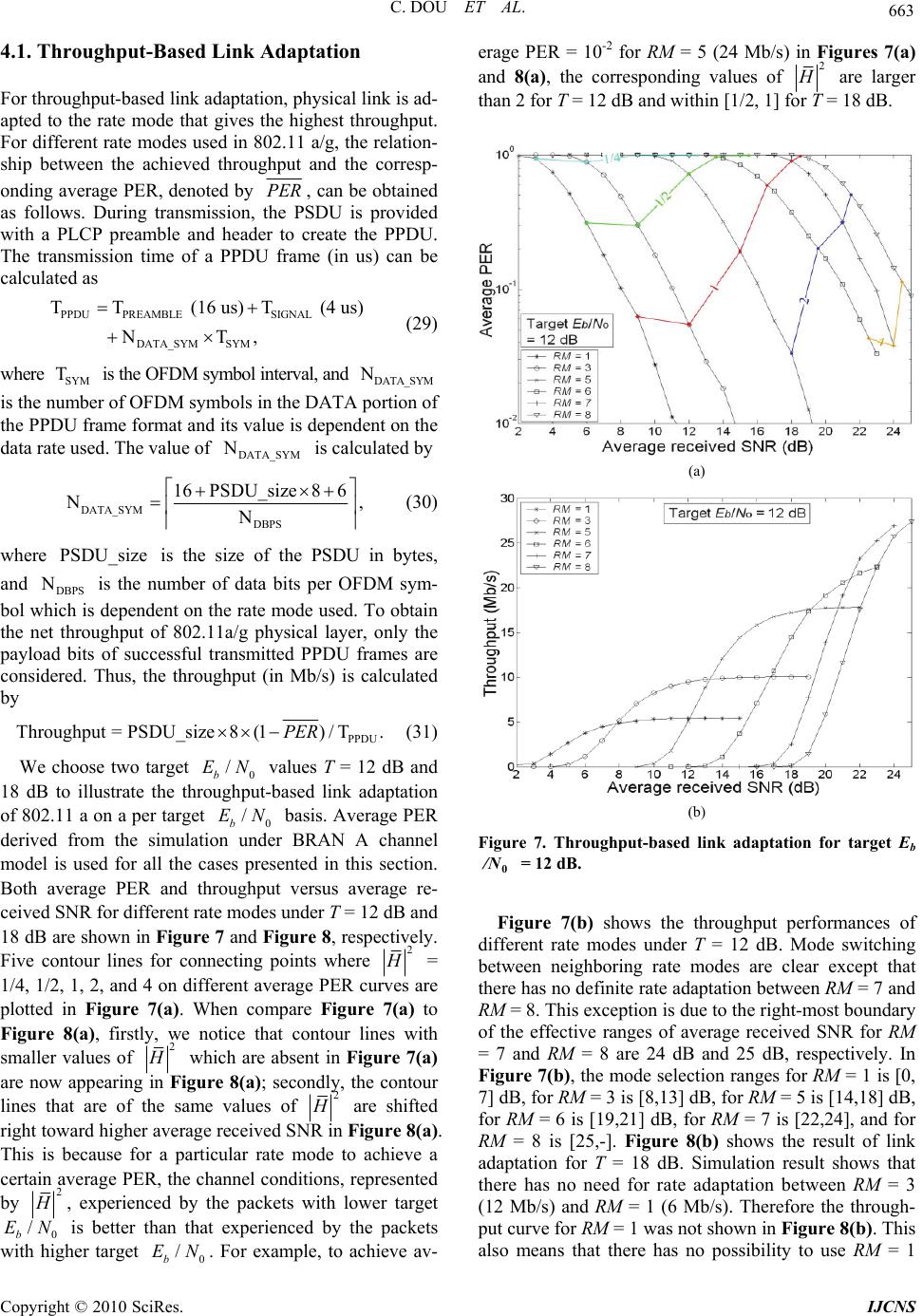 C. DOU ET AL. 663 ut-Based Link Adaptation or throughput-based link adaptation, physical link is ad- 4.1. Throughp F apted to the rate mode that gives the highest throughput. For different rate modes used in 802.11 a/g, the relation- ship between the achieved throughput and the corresp- onding average PER, denoted by PER , can be obtained as follows. During transmission, SDU is provided with a PLCP preamble and header to create the PPDU. The transmission time of a PPDU frame (in us) can be calculated as PPDU T the P (29) where is the OFDM symbol interval, and PREAMBLE SIGNAL DATA_SYM SYM T (16 us)T (4 us) NT, SYM T umbe DATA_SYM N portion ofis the nr of OFDM symbols in the DATA the PPDU frame format and its value is dependent on the data rate used. The value of DATA_SYM N is calculated by DATA_S YM DBPS 16PSDU_size 86 N , N (30) where is the size of the PSDU in bytes, PSDU_size DBPS is the nand Number of data bits per OFDM sym- bol which is dependent on the rate mode used. To obtain the net throughput of 802.11a/g physical layer, only the payload bits of successful transmitted PPDU frames are considered. Thus, the throughput (in Mb/s) is calculated by PPDU Throughput=PSDU_size8(1) / T.PER (31) We choose two target values T = 12 dB 18 0 / b EN oughpu n unde and dB to illustrate the thrt-based link adaptation of 802.11 a on a per target 0 / b EN basis. Average PER derived from the simulatior BRAN A channel model is used for all the cases presented in this section. Both average PER and throughput versus average re- ceived SNR for different rate modes under T = 12 dB and 18 dB are shown in Figure 7 and Figure 8, respectively. Five contour lines for connecting points where 2 H = 1/4, 1/2, 1, 2, and 4 on different average PER curveare plotted in Figure 7(a). When compare Figure 7(a) to Figure 8(a), firstly, we notice that contour lines with smaller values of s 2 H which are absent in Figure 7(a) are now appearingigure 8(a); secondly, the contour lines that are of the same values of in F2 H are shifted right toward higher average received SN Figure 8(a). This is because for a particular rate mode to achieve a certain average PER, the channel conditions, represented by R in 2 H , experienced by the packets with lower target EN is better than that experienced by the packets her target 0 / b EN. For example, to achieve av- erage PER = 10-2 fo 5 (24 Mb/s) in Figures 7(a) and 8(a), the corresponding values of 0 / b with hig r RM =2 H are larger than 2 for T = 12 dB and within [1/2, 1] fo= 18 dB. r T (a) (b) Figure 7. Throughput-basedk adaptation for target Eb lin 0 / N = 12 dB. Figure 7(b) shows the throughput performances of di also means that there has no possibility to use RM = 1 fferent rate modes under T = 12 dB. Mode switching between neighboring rate modes are clear except that there has no definite rate adaptation between RM = 7 and RM = 8. This exception is due to the right-most boundary of the effective ranges of average received SNR for RM = 7 and RM = 8 are 24 dB and 25 dB, respectively. In Figure 7(b), the mode selection ranges for RM = 1 is [0, 7] dB, for RM = 3 is [8,13] dB, for RM = 5 is [14,18] dB, for RM = 6 is [19,21] dB, for RM = 7 is [22,24], and for RM = 8 is [25,-]. Figure 8(b) shows the result of link adaptation for T = 18 dB. Simulation result shows that there has no need for rate adaptation between RM = 3 (12 Mb/s) and RM = 1 (6 Mb/s). Therefore the through- put curve for RM = 1 was not shown in Figure 8(b). This Copyright © 2010 SciRes. IJCNS 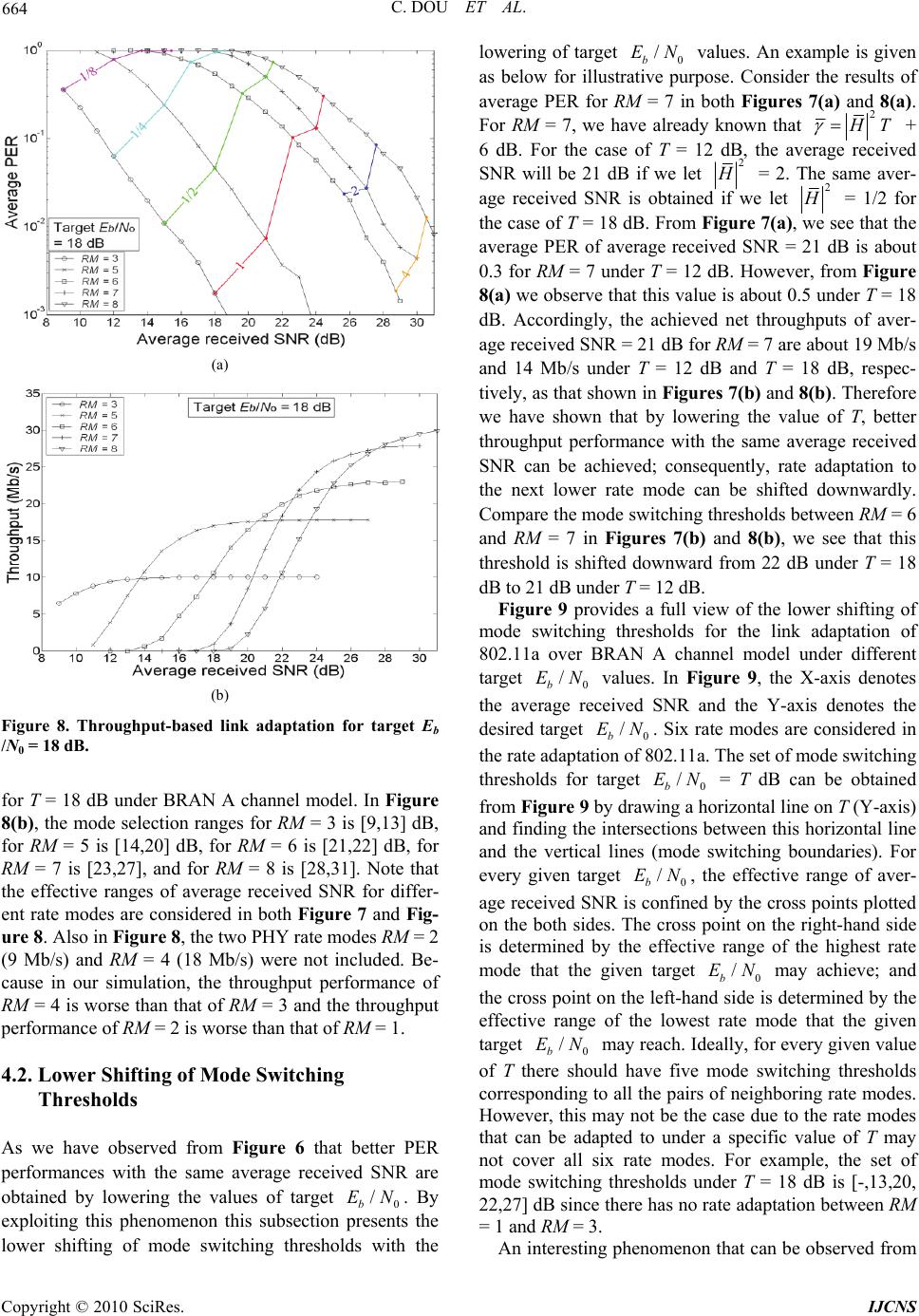 664 C. DOU ET AL. (a) (b) Figure 8. Throughput-basedk adaptation for target Eb /N0 = 18 dB. under BRAN A channel model. In Figure (b), the mode selection ranges for RM = 3 is [9,13] dB, Thresholds s wved from Figure 6 that better PER erformances with the same average received SNR are ds with lin for T = 18 dB 8 for RM = 5 is [14,20] dB, for RM = 6 is [21,22] dB, for RM = 7 is [23,27], and for RM = 8 is [28,31]. Note that the effective ranges of average received SNR for differ- ent rate modes are considered in both Figure 7 and Fig- ure 8. Also in Figure 8, the two PHY rate modes RM = 2 (9 Mb/s) and RM = 4 (18 Mb/s) were not included. Be- cause in our simulation, the throughput performance of RM = 4 is worse than that of RM = 3 and the throughput performance of RM = 2 is worse than that of RM = 1. 4.2. Lower Shifting of Mode Switching e have obserA p obtained by lowering the values of target 0 / b EN. By exploiting this phenomenon this subsection presents the lower shifting of mode switching threshol the lowering of target 0 / b EN values. An example is given as below for illustrative purpose. Consider the results of average PER for RM both Figures 7(a) and 8(a). For RM = 7, we have already known that = 7 in2 H T + 6 dB. For the case of T = 12 dB, the average received SNR will be 21 dB if we let 2 H = 2. Ther- age received SNR is obtained if we let e same av 2 H = 1/2 for the case of T = 18 dB. From Fe 7(a), we see that the average PER of average received SNR = B is about 0.3 for RM = 7 under T = 12 dB. However, from Figure 8(a) we observe that this value is about 0.5 under T = 18 dB. Accordingly, the achieved net throughputs of aver- age received SNR = 21 dB for RM = 7 are about 19 Mb/s and 14 Mb/s under T = 12 dB and T = 18 dB, respec- tively, as that shown in Figures 7(b) and 8(b). Therefore we have shown that by lowering the value of T, better throughput performance with the same average received SNR can be achieved; consequently, rate adaptation to the next lower rate mode can be shifted downwardly. Compare the mode switching thresholds between RM = 6 and RM = 7 in Figures 7(b) and 8(b), we see that this threshold is shifted downward from 22 dB under T = 18 dB to 21 dB under T = 12 dB. Figure 9 provides a full view of the lower shifting of mode switching thresholds fo igur 21 d r the link adaptation of 80 onding An interesting phenomenon that can be observed from 2.11a over BRAN A channel model under different target 0 / b EN values. In Figure 9, the X-axis denotes the average received SNR and the Y-axis denotes the desired ta0 / b EN. Six rate modes are considered in the rate adaptation of 802.11a. The set of mode switching thresholds for 0 / b EN = T dB can be obtained from Figure 9 by drawing a horizontal line on T (Y-axis) and finding the interseetween this horizontal line and the vertical lines (mode switching boundaries). For every given target 0 / b EN, the effective range of aver- age received SNR is confined by the cross points plotted on the both sides. Ts point on the right-hand side is determined by the effective range of the highest rate mode that the given target 0 / b EN may achieve; and the cross point on the left-hand side is determined by the effective range of the lowest rate mode that the given target 0 / b EN may reach. Ideally, for every given value of T there should have five mode switching thresholds corresp to all the pairs of neighboring rate modes. However, this may not be the case due to the rate modes that can be adapted to under a specific value of T may not cover all six rate modes. For example, the set of mode switching thresholds under T = 18 dB is [-,13,20, 22,27] dB since there has no rate adaptation between RM = 1 and RM = 3. rget target ction he cros s b Copyright © 2010 SciRes. IJCNS 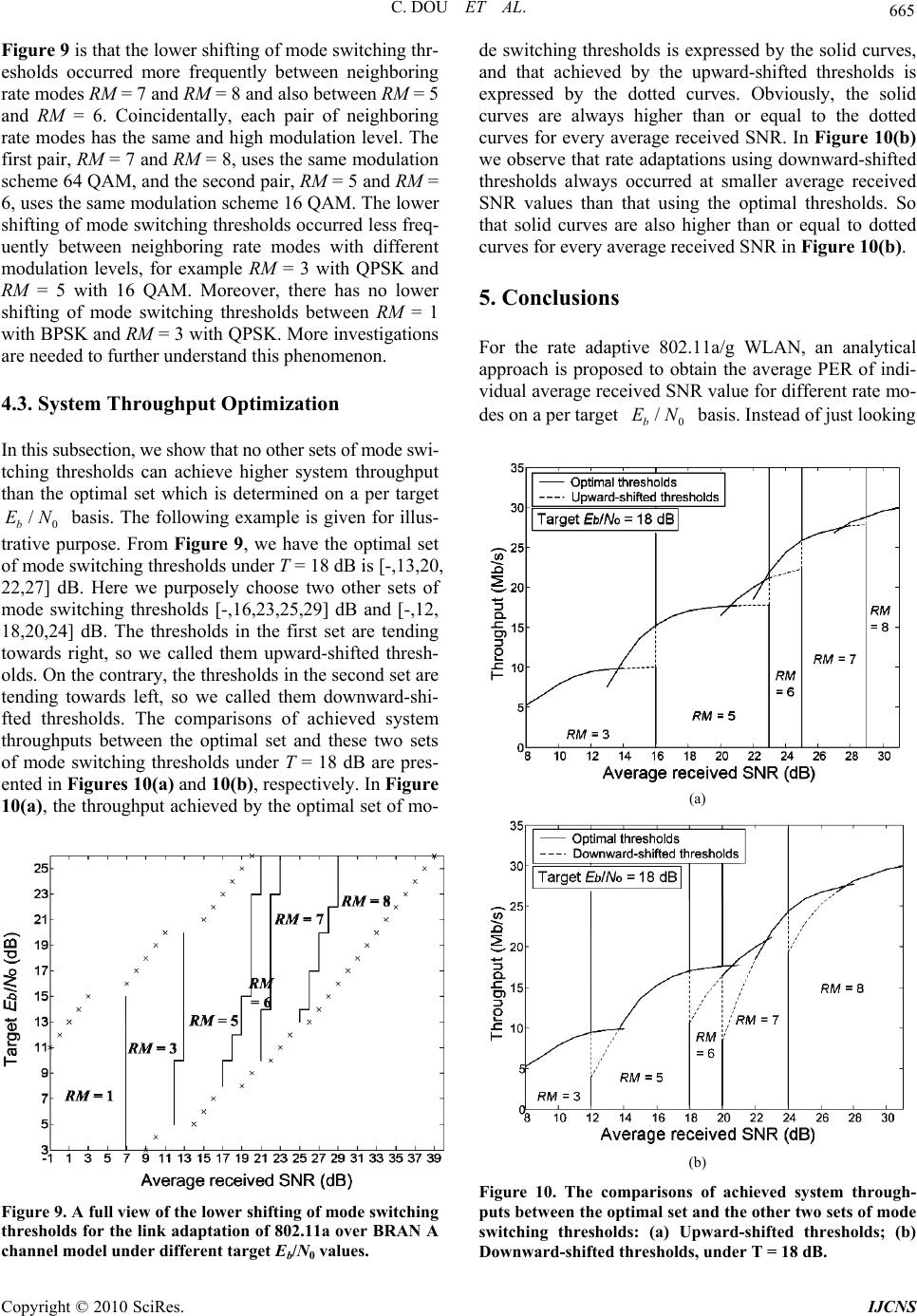 C. DOU ET AL. 665 more frequently between neighboring ra this subsection, we show that no other sets of mode swi- throughput an the optimal set which is determined on a per target 22,27] Figure 9 is that the lower shifting of mode switching thr- esholds occurred te modes RM = 7 and RM = 8 and also between RM = 5 and RM = 6. Coincidentally, each pair of neighboring rate modes has the same and high modulation level. The first pair, RM = 7 and RM = 8, uses the same modulation scheme 64 QAM, and the second pair, RM = 5 and RM = 6, uses the same modulation scheme 16 QAM. The lower shifting of mode switching thresholds occurred less freq- uently between neighboring rate modes with different modulation levels, for example RM = 3 with QPSK and RM = 5 with 16 QAM. Moreover, there has no lower shifting of mode switching thresholds between RM = 1 with BPSK and RM = 3 with QPSK. More investigations are needed to further understand this phenomenon. 4.3. System Throughput Optimization In tching thresholds can achieve higher system th 0 / b EN basis. The following example is given for illus- trative purpose. From Figure 9, we have the optimal set of mode switching thresholds under T = 18 dB is [-,13,20, dB. Here we purposely choose two other sets of mode switching thresholds [-,16,23,25,29] dB and [-,12, 18,20,24] dB. The thresholds in the first set are tending towards right, so we called them upward-shifted thresh- olds. On the contrary, the thresholds in the second set are tending towards left, so we called them downward-shi- fted thresholds. The comparisons of achieved system throughputs between the optimal set and these two sets of mode switching thresholds under T = 18 dB are pres- ented in Figures 10(a) and 10(b), respectively. In Figure 10(a), the throughput achieved by the optimal set of mo- de switching thresholds is expressed by the solid curves, and that achieved by the upward-shifted thresholds is expressed by the dotted curves. Obviously, the solid curves are always higher than or equal to the dotted curves for every average received SNR. In Figure 10(b) we observe that rate adaptations using downward-shifted thresholds always occurred at smaller average received SNR values than that using the optimal thresholds. So that solid curves are also higher than or equal to dotted curves for every average received SNR in Figure 10(b). 5. Conclusions Figure 9. A full view of the lower shifting of mode switching thresholds for the link adaptation of 802.11a over BRAN A channel model under different target Eb/N0 values. ve 802.11a/g WLAN, an analytical tain the average PER of indi- For the rate adapti pproach is proposed to oba vidual average received SNR value for different rate mo- des on a per target 0 / b EN basis. Instead of just looking (a) (b) Figure 10. The comparisons of achieved system through puts between the optimal set the other two sets of mode switching thresholds: (a) Urd-shifted thresholds; (b) - and pwa Downward-shifted thresholds, under T = 18 dB. Copyright © 2010 SciRes. IJCNS 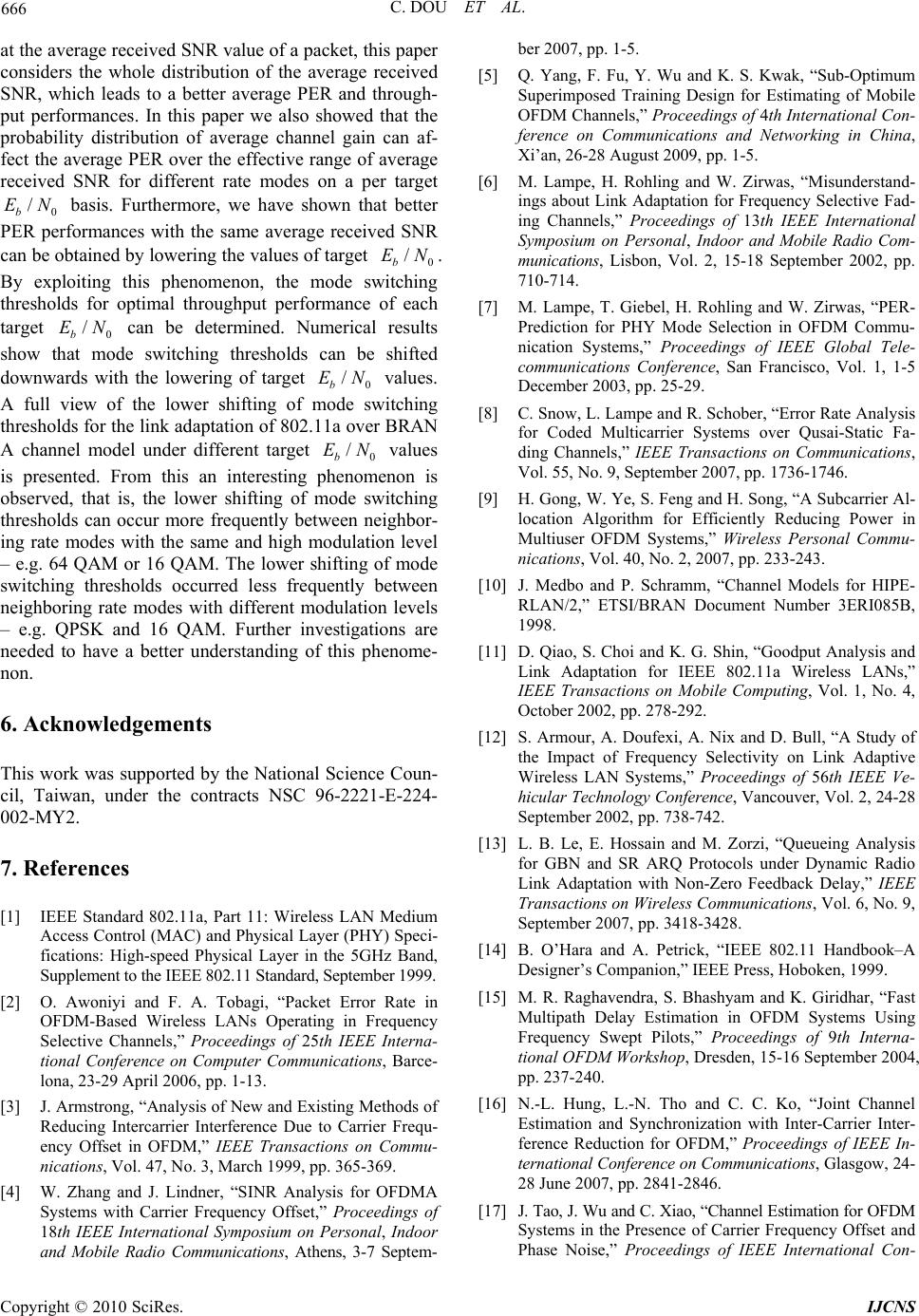 C. DOU ET AL. 666 he National Science Coun- racts NSC 96-2221-E 802.11a, Part 11: Wireless LAN Medium l (MAC) and Physical Layer (PHY) Speci- fications: High-speed Physical Layer in the 5GHz Band, nsactions on Commu- door Proceedings of 4th International Con- IEEE International ystems,” Proceedings of IEEE Global Tele- actions on Communications, Commu- ransactions on Mobile Computing, Vol. 1, No. 4, oceedings of 56th IEEE Ve- o Feedback Delay,” IEEE a- tion for OFDM,” Proceedings of IEEE In- IEEE International Con- at the average received SNR value of a packet, this paper considers the whole distribution of the average received SNR, which leads to a better average PER and through- put performances. In this paper we also showed that the probability distribution of average channel gain can af- fect the average PER over the effective range of average received SNR for different rate modes on a per target 0 / b EN basis. Furthermore, we have shown that better PER performances with the same average received SNR can bebtained by lowering the values of target 0 / b EN. By exploiting this phenomenon, the mode switching thresholds for optimal throughput performance of each target 0 / b EN can be determined. Numerical results show that mode switching thresholds can be shifted downwh the lowering of target 0 / b EN values. A full view of the lower shifting of mode switching thresholds for the link adaptation of 802.11a over BRAN A channel model under different target 0 / b EN values is presented. From this an interesting phenomenon is observed, that is, the lower shifting of mode switching thresholds can occur more frequently between neighbor- ing rate modes with the same and high modulation level – e.g. 64 QAM or 16 QAM. The lower shifting of mode switching thresholds occurred less frequently between neighboring rate modes with different modulation levels – e.g. QPSK and 16 QAM. Further investigations are needed to have a better understanding of this phenome- non. 6. Acknowledgements o ards wit This work was supported by t il, Taiwan, under the contc 0 -224- hicular Technology Conference, Vancouver, Vol. 2, 24-28 September 2002, pp. 738-742. [13] L. B. Le, E. Hossain and M. Zorzi, “Queueing Analysis for GBN and SR ARQ Protocols under Dynamic Radio Link Adaptation with Non-Zer 02-MY2. 7. References [1] IEEE Standard Access Contro Tran Supplement to the IEEE 802.11 Standard, September 1999. [2] O. Awoniyi and F. A. Tobagi, “Packet Error Rate in OFDM-Based Wireless LANs Operating in Frequency Selective Channels,” Proceedings of 25th IEEE Interna- tional Conference on Computer Communications, Barce- lona, 23-29 April 2006, pp. 1-13. [3] J. Armstrong, “Analysis of New and Existing Methods of Reducing Intercarrier Interference Due to Carrier Frequ- ency Offset in OFDM,” IEEE Tra nications, Vol. 47, No. 3, March 1999, pp. 365-369. [4] W. Zhang and J. Lindner, “SINR Analysis for OFDMA Systems with Carrier Frequency Offset,” Proceedings of 18th IEEE International Symposium on Personal, In tern and Mobile Radio Communications, Athens, 3-7 Septem- ber 2007, pp. 1-5. [5] Q. Yang, F. Fu, Y. Wu and K. S. Kwak, “Sub-Optimum Superimposed Training Design for Estimating of Mobile OFDM Channels,” ference on Communications and Networking in China, Xi’an, 26-28 August 2009, pp. 1-5. [6] M. Lampe, H. Rohling and W. Zirwas, “Misunderstand- ings about Link Adaptation for Frequency Selective Fad- ing Channels,” Proceedings of 13th Symposium on Personal, Indoor and Mobile Radio Com- munications, Lisbon, Vol. 2, 15-18 September 2002, pp. 710-714. [7] M. Lampe, T. Giebel, H. Rohling and W. Zirwas, “PER- Prediction for PHY Mode Selection in OFDM Commu- nication S communications Conference, San Francisco, Vol. 1, 1-5 December 2003, pp. 25-29. [8] C. Snow, L. Lampe and R. Schober, “Error Rate Analysis for Coded Multicarrier Systems over Qusai-Static Fa- ding Channels,” IEEE Trans Vol. 55, No. 9, September 2007, pp. 1736-1746. [9] H. Gong, W. Ye, S. Feng and H. Song, “A Subcarrier Al- location Algorithm for Efficiently Reducing Power in Multiuser OFDM Systems,” Wireless Personal nications, Vol. 40, No. 2, 2007, pp. 233-243. [10] J. Medbo and P. Schramm, “Channel Models for HIPE- RLAN/2,” ETSI/BRAN Document Number 3ERI085B, 1998. [11] D. Qiao, S. Choi and K. G. Shin, “Goodput Analysis and Link Adaptation for IEEE 802.11a Wireless LANs,” IEEE T October 2002, pp. 278-292. [12] S. Armour, A. Doufexi, A. Nix and D. Bull, “A Study of the Impact of Frequency Selectivity on Link Adaptive Wireless LAN Systems,” Pr sactions on Wireless Communications, Vol. 6, No. 9, September 2007, pp. 3418-3428. [14] B. O’Hara and A. Petrick, “IEEE 802.11 Handbook–A Designer’s Companion,” IEEE Press, Hoboken, 1999. [15] M. R. Raghavendra, S. Bhashyam and K. Giridhar, “Fast Multipath Delay Estimation in OFDM Systems Using Frequency Swept Pilots,” Proceedings of 9th Intern tional OFDM Workshop, Dresden, 15-16 September 2004, pp. 237-240. [16] N.-L. Hung, L.-N. Tho and C. C. Ko, “Joint Channel Estimation and Synchronization with Inter-Carrier Inter- ference Reduc ational Conference on Communications, Glasgow, 24- 28 June 2007, pp. 2841-2846. [17] J. Tao, J. Wu and C. Xiao, “Channel Estimation for OFDM Systems in the Presence of Carrier Frequency Offset and Phase Noise,” Proceedings of Copyright © 2010 SciRes. IJCNS 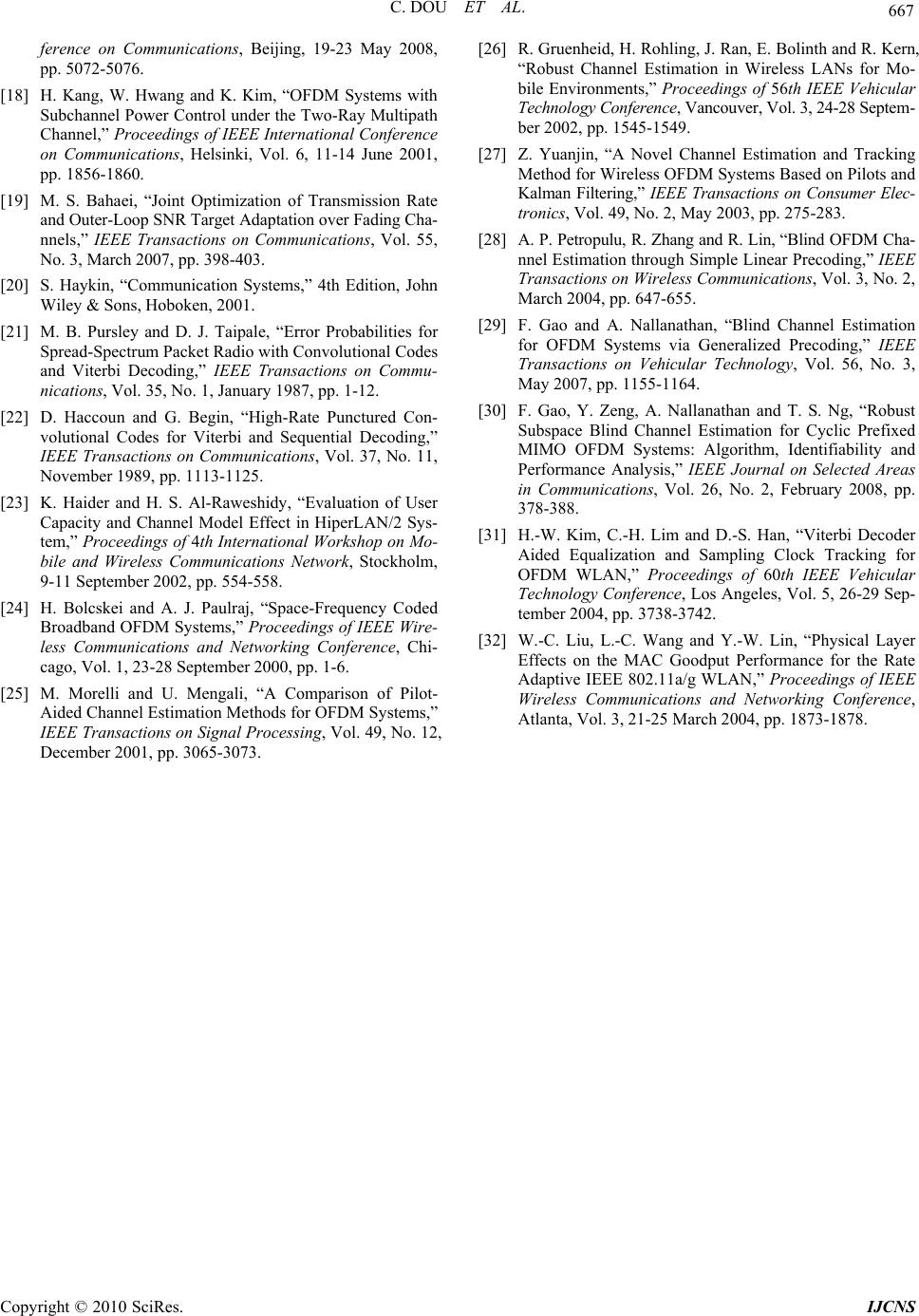 C. DOU ET AL. Copyright © 2010 SciRes. IJCNS 667 edings of IEEE International Conference nsactions on Communications, Vol. 55, ransactions on Commu- ional Workshop on Mo- ng Conference, Chi- . 49, No. 12 ireless LANs for Mo- M Systems Based on Pilots and ,” IEEE eneralized Precoding,” IEEE stimation for Cyclic Prefixed ualization and Sampling Clock Tracking for t Performance for the Rate ference on Communications, Beijing, 19-23 May 2008, pp. 5072-5076. [18] H. Kang, W. Hwang and K. Kim, “OFDM Systems with Subchannel Power Control under the Two-Ray Multipath Channel,” Proce on Communications, Helsinki, Vol. 6, 11-14 June 2001, pp. 1856-1860. [19] M. S. Bahaei, “Joint Optimization of Transmission Rate and Outer-Loop SNR Target Adaptation over Fading Cha- nnels,” IEEE Tra No. 3, March 2007, pp. 398-403. [20] S. Haykin, “Communication Systems,” 4th Edition, John Wiley & Sons, Hoboken, 2001. [21] M. B. Pursley and D. J. Taipale, “Error Probabilities for Spread-Spectrum Packet Radio with Convolutional Codes and Viterbi Decoding,” IEEE T nications, Vol. 35, No. 1, January 1987, pp. 1-12. [22] D. Haccoun and G. Begin, “High-Rate Punctured Con- volutional Codes for Viterbi and Sequential Decoding,” IEEE Transactions on Communications, Vol. 37, No. 11, MIMO OFDM Systems: Algorithm, Identifiability and Performance Analysis,” IEEE Journal on Selected Areas in Communications, Vol. 26, No. 2, February 2008, pp. 378-388. [31] H.-W. Kim, C.-H. Lim and D.-S. Han, “Viterbi Decoder Aided Eq November 1989, pp. 1113-1125. [23] K. Haider and H. S. Al-Raweshidy, “Evaluation of User Capacity and Channel Model Effect in HiperLAN/2 Sys- tem,” Proceedings of 4th Internat bile and Wireless Communications Network, Stockholm, 9-11 September 2002, pp. 554-558. [24] H. Bolcskei and A. J. Paulraj, “Space-Frequency Coded Broadband OFDM Systems,” Proceedings of IEEE Wire- less Communications and Networki cago, Vol. 1, 23-28 September 2000, pp. 1-6. [25] M. Morelli and U. Mengali, “A Comparison of Pilot- Aided Channel Estimation Methods for OFDM Systems,” IEEE Transactions on Signal Processing, Vol, Ada December 2001, pp. 3065-3073. [26] R. Gruenheid, H. Rohling, J. Ran, E. Bolinth and R. Kern, “Robust Channel Estimation in W bile Environments,” Proceedings of 56th IEEE Vehicular Technology Conference, Vancouver, Vol. 3, 24-28 Septem- ber 2002, pp. 1545-1549. [27] Z. Yuanjin, “A Novel Channel Estimation and Tracking Method for Wireless OFD Kalman Filtering,” IEEE Transactions on Consumer Elec- tronics, Vol. 49, No. 2, May 2003, pp. 275-283. [28] A. P. Petropulu, R. Zhang and R. Lin, “Blind OFDM Cha- nnel Estimation through Simple Linear Precoding Transactions on Wireless Communications, Vol. 3, No. 2, March 2004, pp. 647-655. [29] F. Gao and A. Nallanathan, “Blind Channel Estimation for OFDM Systems via G Transactions on Vehicular Technology, Vol. 56, No. 3, May 2007, pp. 1155-1164. [30] F. Gao, Y. Zeng, A. Nallanathan and T. S. Ng, “Robust Subspace Blind Channel E OFDM WLAN,” Proceedings of 60th IEEE Vehicular Technology Conference, Los Angeles, Vol. 5, 26-29 Sep- tember 2004, pp. 3738-3742. [32] W.-C. Liu, L.-C. Wang and Y.-W. Lin, “Physical Layer Effects on the MAC Goodpu ptive IEEE 802.11a/g WLAN,” Proceedings of IEEE Wireless Communications and Networking Conference, Atlanta, Vol. 3, 21-25 March 2004, pp. 1873-1878. |

